M113 armored personnel carrier
The M113 is a fully tracked armored personnel carrier (APC) that was developed and produced by the Food Machinery Corp (FMC). The M113 was sent to United States Army Europe to replace the mechanized infantry's M59 [6]APCs from 1961. The M113 was first used in combat in April 1962 after the United States provided the South Vietnamese Army (ARVN) with heavy weaponry such as the M113, under the Military Assistance Command, Vietnam (MACV) program. Eventually, the M113 was the most widely used armored vehicle of the U.S. Army in the Vietnam War and was used to break through heavy thickets in the midst of the jungle to attack and overrun enemy positions. It was largely known as an "APC" or an "ACAV" (armored cavalry assault vehicle) by the allied forces.[7]
| M113 armored personnel carrier | |
|---|---|
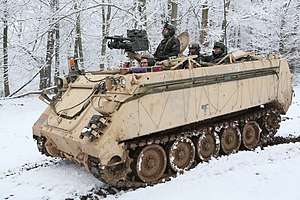 A U.S. Army M113 of 1st Battalion, 4th Infantry Regiment provides overwatch while conducting recon operations during exercise Allied Spirit at the Joint Multinational Readiness Center in Hohenfels, Germany in 2015. | |
| Type | Armored personnel carrier |
| Place of origin | United States |
| Service history | |
| In service | 1960–present |
| Used by | See Operators |
| Wars |
|
| Production history | |
| No. built | ≈80,000 (all variants)[2] |
| Variants | Numerous, see text |
| Specifications | |
| Mass | 12.3 tonnes (13.6 short tons; 12.1 long tons) |
| Length | 4.863 metres (15 ft 11.5 in) |
| Width | 2.686 metres (8 ft 9.7 in) |
| Height | 2.5 metres (8 ft 2 in) |
| Crew | 2 |
| Passengers | 11 passengers |
| Armor | 5083 Aluminium Alloy 28–44 millimetres (1.1–1.7 in)[3][4][5] |
Main armament | M2 Browning machine gun |
Secondary armament | varies (see text) |
| Engine | Detroit Diesel 6V53T, 6-cylinder diesel engine 275 hp (205 kW) |
| Power/weight | 22.36 hp/tonne |
| Suspension | torsion bar, 5 road wheels |
Operational range | 480 km (300 mi) |
| Maximum speed | 67.6 km/h (42.0 mph), 5.8 km/h (3.6 mph) swimming |
The M113 was the first aluminum hull combat vehicle to be put into mass production. Much lighter than earlier similar vehicles, its aluminum armor was designed to be thick enough to protect the crew and passengers against small arms fire, but light enough that the vehicle was air transportable and moderately amphibious.
In the U.S. Army, the M113 series have long been replaced as front-line combat vehicles by the M2 and M3 Bradleys, but large numbers are still used in support roles such as armored ambulance, mortar carrier, engineer vehicle, and command vehicle. The U.S. Army's heavy brigade combat teams are equipped with approximately 6,000 M113s and 4,000 Bradleys.
The M113's versatility spawned a wide variety of adaptations that live on worldwide and in U.S. service. These variants together currently represent about half of U.S. Army armored vehicles. To date, it is estimated that over 80,000 M113s of all types have been produced and used by over 50 countries worldwide, making it one of the most widely used armored fighting vehicles of all time.[8] The Military Channel's Top Ten series named the M113 the most significant infantry vehicle in history.[9]
The U.S. Army planned to retire the M113 family of vehicles by 2018, seeking replacement with the GCV Infantry Fighting Vehicle program,[10] but now replacement of the M113 has fallen to the Armored Multi-Purpose Vehicle (AMPV) program.[11] Thousands of M113s continue to see combat service in the Israel Defense Forces, although as of 2014 the IDF was seeking to gradually replace many of its 6,000 M113s, with Namer APCs.[12]
Development
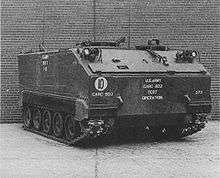
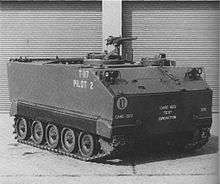
The M113 was developed by Food Machinery Corp. (FMC), which had produced the earlier M59 and M75 Armored personnel carriers. The M113 bears a very strong resemblance to both of these earlier vehicles. The M75 was too heavy and expensive to be useful, as its weight precluded amphibious use and transport by air. The lightened M59 addressed both of these problems, but ended up with too little armor, and was unreliable as a result of efforts to reduce its cost.
The army was looking for a vehicle that combined the best features of both designs, the "airborne armored multi-purpose vehicle family" (AAM-PVF).[13] of all-purpose, all-terrain armored fighting vehicles FMC had been working with Kaiser Aluminum and Chemical Co. in the late 1950s to develop suitable aluminum armor. It was known that use of this armor could produce a vehicle that provided the protection of the M75 and the low weight and mobility of the M59.
FMC responded with two proposals; two versions of the aluminum T113—a thickly and a more thinly-armored one, along with the similar but mostly steel T117. The thickly-armored version of the T113 - effectively the prototype of the M113 - was chosen because it weighed less than its steel competitor, whilst offering the same level of protection. An improved T113 design, the T113E1, was adopted by the U.S. Army in 1960 as the "M113". A diesel prototype, T113E2, was put into production in 1964 as the "M113A1", and quickly supplanted the gasoline-engined M113.[14] In 1994, FMC transferred the M113's production over to its newly formed defense subsidiary, United Defense. Then in 2005, United Defense was acquired by BAE Systems.
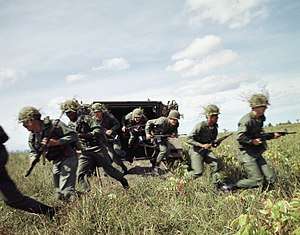
The M113 was developed to provide a survivable and reliable light tracked vehicle able to be air-lifted and air-dropped by C-130 and C-141 transport planes. The original concept was that the vehicle would be used solely for transportation, bringing the troops forward under armor and then having them dismount for combat, after which the M113 would retreat to the rear. Entering service with the U.S. Army in 1960, the M113 required only two crewmen, a driver and a commander, and carried 11 passengers inside the vehicle. Its main armament was a single .50-caliber (12.7 mm) M2 Browning machine gun operated by the commander.
On March 30th 1962, the first batch of 32 M113s arrived in Vietnam, and were sent to two Army of the Republic of Vietnam (ARVN) mechanized rifle companies, each equipped with 15 of the APCs.[15] On 11 June 1962, the two mechanized units were fielded for the first time.[16] During the Battle of Ap Bac in January 1963, at least fourteen of the exposed .50 caliber gunners aboard the M113s were killed in action, necessitating modifications to improve crew survivability.[17] Makeshift shields formed from metal salvaged from the hulls of sunken ships were soon fitted to the carriers, affording better protection. However it was found that this material could be penetrated by small arms fire, so subsequent shields were constructed from scrapped armored vehicles.[18]
The ARVN 80th Ordnance Unit in South Vietnam developed the shield idea further and commenced engineering general issue gun shields for the M113.[18] These shields became the predecessor to the standardized armored cavalry assault vehicle (or ACAV) variant and were issued to all ARVN mechanized units during the early 1960s. The ARVNs had modified the M113s to function as "amphibious light tanks"[19] and not as battle taxis as U.S. designers had intended. Instead of an armored personnel carrier, the ARVN used the carried infantry as extra "dismountable soldiers" in "an oversized tank crew".[19] These "ACAV" sets were eventually adapted to U.S. Army M113s with the arrival of the army's conventional forces in 1965. The vehicles continued to operate in the role of a light tank and reconnaissance vehicle, and not as designed in theater. Still, the M113 could carry 11 infantrymen inside, with two crewmen operating it.

The U.S. Army, after berating the South Vietnamese for flouting battle doctrine, came out with their own ACAV version. This more or less standardized ACAV kit included shields and a circular turret for the .50-caliber M2 machine gun in the track commander (TC) position, two M60 machine guns with shields for the left and right rear positions, and "belly armor"—steel armor bolted from the front bottom extending 1/2 to 2/3 of the way towards the bottom rear of the M113. The two rear machine gunners could fire their weapons while standing inside the rectangular open cargo hatch. This transformed the M113 into a fighting vehicle, but the vehicle still suffered from its lightly armored configuration, having never been designed for such a role. Canada also adopted the ACAV kits when employing the M113A2 during peacekeeping operations in the Balkans in the 1990s.
In order to improve the fighting ability of the mounted troops, a number of experiments were carried out in the 1960s under the MICV-65 project, which aimed to develop a true infantry fighting vehicle rather than an armored personnel carrier. Pacific Car and Foundry entered the steel-armored XM701, but this proved to be too slow and too heavy to be airmobile, even in the C-141. FMC entered the XM734, which was largely the ACAV M113, but whereas the M113 seated the troops facing inward on benches along the walls, the XM734 sat them facing outwards on a central bench. Four gun ports and vision blocks were added on each side to allow the seated troops to fire even while under cover. Although neither the XM701 or XM734 were deemed worthwhile to produce, FMC continued development of their version as the XM765 advanced infantry fighting vehicle (AIFV). The AIFV was sold to a number of third party-users in the 1970s, including the Netherlands, the Philippines and Belgium.
Modifications
Modified versions of the Vietnam War ACAV sets have been deployed to Iraq (formerly referred to as "Southwest Asia" within the U.S. military) to equip the standard M113s still in service. The circular .50 caliber gun shields have been modified, while the rear port and starboard gun stations have been deleted for service in that region. Some of these modified vehicles have been utilized for convoy escort duties.
The M113 has relatively light armor, but it can be augmented with add-on steel plates for improved ballistic protection. Also, reactive armor and slat armor can be added for protection against rocket-propelled grenade. Windowed gunshields developed by an armorer in Iraq are reminiscent of ACAV vehicle modifications so effective in Southeast Asia (Vietnam War).
Band tracks made of rubber are in use by Canadian and other forces to enable stealthy operation, less damage to paved roads, higher speed, less maintenance, access to terrain where operation of wheeled vehicles is impractical and less vibration and rolling resistance.[20]
Most of the 13,000 M113s that are still in U.S. Army service have been upgraded to the A3 variant. The current U.S. Army M113 fleet includes a mix of M113A2 and A3 variants and other derivatives equipped with the most recent RISE (reliability improvements for selected equipment) package. The standard RISE package includes an upgraded propulsion system (turbocharged engine and new transmission), greatly improved driver controls (new power brakes and conventional steering controls), external fuel tanks, and 200-amp alternator with four batteries. Additional A3 improvements include the incorporation of spall liners and provision for mounting external armor.
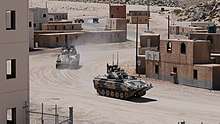
The future M113A3 fleet is planned to include a number of vehicles that will have high speed digital networks and data transfer systems. The M113A3 digitization program includes applying appliqué hardware, software, and installation kits and hosting them in the M113 FOV.
The M113 has also been adopted to replace the aging fleet of visually modified M551s being used to simulate Russian-made combat vehicles at the U.S. Army's National Training Center in Fort Irwin, California. These M113s, like the M551s they replaced, have also been modified to resemble enemy tanks and APCs, such as the T-80 and BMP-2. One of the advantages of the M113 being used to simulate the latter is that the infantry squad can now ride inside the simulated BMP instead of in a truck accompanying a tank masquerading as one, as was often the case with the M551s.
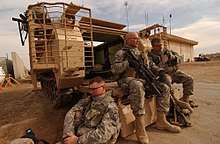
Nicknames
The M113 has received a variety of nicknames over the years. The South Vietnamese Army (ARVN) called it the "green dragon".[21] United States troops tended to refer to the M113 simply as a "113" (spoken as "one-one-three"), a "track"[22] or an "ACAV". The Israel Defense Forces employ the M113 in many different variants, all designed in Israel, and have given each of them official names, from the baseline "Bardelas" (lit. Cheetah) to the "Nagmash" (Hebrew acronym equivalent to "APC"), "Nagman", and "Kasman" variants for urban combat up to the "Zelda" and "Zelda 2", which are fitted with ERA-suites.[23] The Australian Army refers to its M113A1s as "buckets", "bush taxis"[24] and modified M113A1s fitted with 76 mm turrets as "beasts". The German Army has various nicknames, depending on location and branch of service, including "elephant shoe",[25] "Tank Wedge"[26] and "bathtub". In Spain's Army is known as "TOA", the acronym of Transporte Oruga Acorazado that is the literal translation of Armored Personal Carrier.
Design
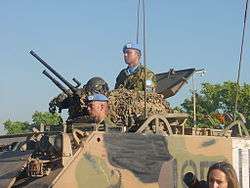
Armament
The basic M113 armored personnel carrier can be fitted with a number of weapon systems. The most common weapon fit is a single .50 caliber M2 machine gun. However, the mount can also be fitted with a 40 mm Mk 19 automatic grenade launcher. A number of anti-tank weapons could be fitted to the standard variant: the U.S. Army developed kits that allowed the M47 Dragon and BGM-71 TOW anti-tank missile systems to be mounted. In the case of the M47, the system mated to the existing machine gun mount, without having to remove the machine gun. This allowed the commander to use both weapons. A large array of turrets and fixed mounts are available to mount high explosive cannon ranging from 20 mm to 105 mm on to the M113 series, making them function as assault guns and fire support; while in many cases still having room inside to carry dismounted infantry or cavalry scouts.
Armor
The M113 is built of 5083 aircraft-quality aluminum alloy. Aluminium alloy is fairly durable, but it still requires nearly three times the thickness of steel for an equivalent level of protection,[27] meaning it was only designed for all-around 7.62mm and shell splinter protection.[28][29] The M113A3 could also mount applique armor gave protection from 14.5mm threats and landmines.[4] In comparison, a modern APC such as the Stryker has all-around 7.62mm armor-piercing protection, plus 14.5 mm protection on the front, sides, and rear, and a protection against antipersonnel mines.[30]
Mobility
.jpg)
Its weight allows the use of a relatively small engine to power the vehicle, a Detroit 6V53 V6 two-stroke diesel engine of 318 cubic inches (5,210 cc)[31] with an Allison TX-100-1 three-speed automatic transmission. This allows the vehicle to carry a large payload cross-country and to be transported by fixed- and rotary-wing aircraft. Original production M113s can swim without deploying flotation curtains, using only a front-mounted trim vane; they are propelled in the water by their tracks.
Operational history
Vietnam
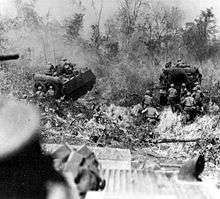
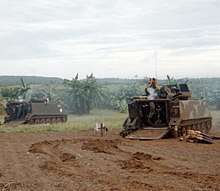
The Vietnam War was the first combat opportunity for "mechanized" infantry, a technically new type of infantry with its roots in the armored infantry of World War II, now using the M113 armored personnel carrier. In addition, armored cavalry squadrons in Vietnam consisted largely of M113s, after replacing the intended M114 in a variety of roles, and armor battalions contained M113s within their headquarters companies, such as the maintenance section, medical section, vehicle recovery section, mortar section, and the scout (reconnaissance) section. United States Army mechanized infantry units in Vietnam were fully equipped with the M113 APC/ACAV, which consisted of one headquarters company and three line companies, normally with an authorized strength of approximately 900 men. Ten U.S. mechanized infantry battalions were deployed to Vietnam from 1965 until their departure in 1972.[32][Notes 1]
Company D, 16th Armor, 173rd Airborne Brigade was the first U.S. Army armor unit deployed to Vietnam. It originally consisted of three platoons of M113s and a platoon of 90mm M56 Scorpion self-propelled anti-tank guns (SPAT). It was the only independent armor company in the history of the U.S. Army. Upon the company's arrival in Vietnam, a fourth line platoon was added; this was equipped with M106 4.2 in. mortar carriers (modified M113s). The mortar platoon often operated with Brigade infantry units to provide indirect fire support. It also deployed at times as a dismounted infantry unit. The remaining SPATS platoon was reequipped with M113s in late 1966 and the mortar platoon was deactivated in early 1967. From early 1967, D/16th had three line platoons equipped with M113s and eventually, its diesel version, the M113A1. It also standardized in late 1968 with three machine guns per track, one M2 .50 caliber and two M60 machine guns mounted on each side. After several years, the machine gun array varied considerably from APC to APC. The company conducted search and destroy missions, road and firebase security. Twenty-five D/16th paratroopers were killed in action and many more were wounded during the course of the war. D Company's largest battle took place on 4 March 1968 at North Tuy Hoa. "During the day, the company lost 5 men killed, 16 wounded, and 3 missing (who are believed dead as two unrecogizable [sic] bodies were found). The enemy took a much greater loss. An estimated 2 enemy battalions, 85th Main Force (VC) and the 95th NVA Regiment, were rendered ineffective as they had 297 KIAs, with D/16th Armor receiving credit for killing 218."[33] The revised official count for D/16 was 8 KIA and 21 WIA. The company commander, Captain Robert Helmick, was awarded the DSC, and many D/16th soldiers earned awards for valor. D Company, 16th Armor was awarded a Meritorious Unit Award for its actions in Vietnam. It was deactivated in 1969 and the company's M113s were distributed to E Company, 17th Cavalry, 173rd Airborne Brigade.[34]
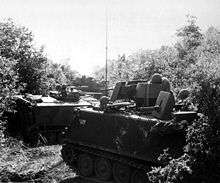
The M113s were instrumental in conducting Reconnaissance in force (RIFs), search and destroy missions, and large invasions (incursions) such as the U.S. invasion of Cambodia on 1 May 1970 and later Laos (Operation Lam Son 719) in 1971; all of which used the M113 as the primary work horse for moving the ground armies. While operating with cavalry and armor units, the M113s often worked in conjunction with U.S. M48 Patton and M551 Sheridan tanks. During the Vietnam War, U.S. Army gun trucks, along with V-100 armored cars, conducted convoy escorts for military traffic.
The USAF used M113 and M113A1 ACAV vehicles in USAF security police squadrons, which provided air base ground defense support in Vietnam. Also, M113s were supplied to the ARVN. One notable ARVN unit equipped with the M113 APC, the 3d Armored Cavalry Squadron, earned the Presidential Unit Citation.[35][36] Additional M113s were supplied to the Cambodian Khmer National Armed Forces, equipped with a turret for the machine gun and a M40 recoilless rifle mounted on the roof.
The Army of the Republic of Vietnam also used M113 armored personnel carriers. In 1975, 1381 ARVN M113s were destroyed and captured. Losses in other years are unknown.[37]
The Australian Army also used the M113 in Vietnam. After initial experiences showed that the crew commander was too vulnerable to fire, the Australians tried a number of different gun shields and turrets, eventually standardizing with the Cadillac-Cage T-50 turret fitted with two .30 cal Browning machine guns, or a single .30-single .50 combination. Other turrets were tried as were various gun shields, the main design of which was similar to the gun shield used on the U.S. M113 ACAV version.
In addition, the Australians operated an M113 variant fitted with a Saladin armored car turret, with a 76 mm gun as a fire support vehicle, or FSV, for infantry fire support. This has now also been removed from service.
Subsequent to Vietnam all Australian M113 troop carriers were fitted with the T50 turret. The FSV was eventually phased out and replaced with a modernized version known as an "MRV" (medium reconnaissance vehicle). The MRV featured a Scorpion turret with 76 mm gun, improved fire control, and passive night vision equipment.
Regiments using the M113 included former Citizens' Military Forces (CMF) units like the 4/19th Prince of Wales Light Horse Regiment (Armoured Reconnaissance) and Regular units such as 2ns Cavalry regiment (Armoured Reconnaisdsance) and 3/4th Cavalry Regiment (APC Regiment) An Armoured Reconnaissance Troop consisted of Alpha Track - Charlie Track (M113 LRV) Bravo - Delta Track (M113 MRV) Echo Track (M113 APC) with Assault Section (Armoured Infantry) later known as Scouts... Light Reconnaissance Vehicle (LRV) - 50/30 cal MG in Cadillac-Cage T-50 turret Armoured Personnel Carrier (APC) - 30/30 cal MG in Cadillac-Cage T-50 turret Medium Reconnaissance Vehicle (MRV) - Saladin Turret (later Scorpion turret) - formerly known as a Fire Support Vehicle
Israel
The Israel Defense Forces are the second largest user of the M113 after the United States, with over 6000 of the vehicles in service.
In 1967 some Jordanian M113 were captured in the West Bank during the Six-Day War and were integrated into the Israeli Army. In 1970 Israel started to receive the better armored M113A1 to replace the antiquated half-tracks. The IDF M-113s were armed with M2 HB machine guns, and two MAG 7.62 mm machine guns on either side of the upper crew compartment door.
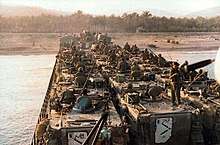
The M113 took part in the Yom Kippur War in October 1973, when the IDF was equipped with 448 M113s that saw action on the Sinai and Golan fronts. They proved inadequate for direct fighting due to their poor armor protection. In the Battle of Buq'atta most of the 7th Recon Company was wiped out while trying to assault Syrian commandos with their M-113s.[38] They were used by the IDF in the 1978 South Lebanon conflict. In the 1982 Lebanon War, they saw heavy action. PLO ambushes with RPGs caused extensive casualties because of the tendency of the M113's aluminum armor to catch on fire after being hit by anti-tank weapons. Israeli infantrymen being ferried by M113s learned to quickly dismount and fight on foot when engaged.[39] By the time of the Siege of Beirut, M113s were only used to carry supplies to the front line, always stopping at least 100 meters from enemy lines. M113s were subsequently used by both the IDF and the South Lebanon Army during the South Lebanon conflict.
The IDF utilized M113s during the First Intifada and the Second Intifada. In May 2004, two fully laden IDF M113s were destroyed by IEDs in the Gaza Strip, killing 11 soldiers, all those inside the vehicles on both occasions. This became known in Israel as the "APC disaster." The vulnerability of the M113 armored personnel carrier to IEDs and RPGs led the IDF to later begin to develop the Namer APC.[40] M113s were used again in the 2006 Lebanon War and Operation Cast Lead.
_(pan).jpg)
In 2014, during the first wave of the IDF's ground incursion into Gaza in Operation Protective Edge, a Hamas RPG-29 destroyed a fully loaded M113 in Gaza during the Battle of Shuja'iyya, killing all seven Golani Brigade soldiers inside the vehicle. As a result, the IDF faced calls from the Israeli public to build more Namer APCs over the next decade and to gradually reduce the number of M113s used in its future combat operations.[41] A group of 30 Israeli reserve soldiers subsequently notified their commanders that they would refuse to enter the Gaza Strip in M113s.[42]
The Israel Defense Forces still operates large numbers of the M113, maintaining a fleet of 6,000 of the vehicles. On numerous occasions since their introduction in the late 1960s, the IDF's M113s have proven vulnerable to modern anti-tank missiles, IEDs, and RPGs, resulting in the deaths of many Israeli soldiers riding inside the vehicles. The IDF has nonetheless been unable to replace the use of them in combat operations, due to budget constraints in equipping its large mechanized infantry regiments. Israel is also prototyping the Eitan (Hebrew for steadfast), an eight-wheeled armored fighting vehicle to replace their M113s. Designed to serve alongside the tracked Namer, the Eitan is planned to be cheaper and lighter, at 35 tons, incorporating an active protection system and a turret. They are expected to begin replacing the M113 starting in 2020.[43][44] However, due to the slow rate of production of replacement APCs, the IDF is expected to be dependent on the M113 well into the 2020s.[12] The IDF has also increased production of Namer APCs to replace the M113.
Law enforcement
M113s have been adopted by numerous law enforcement agencies. An M113 belonging to the Midland County Sheriff's Department was used in the 2008 raid of the Fundamentalist Church of Jesus Christ of Latter Day Saints compound.[45] The Osceola County, FL Sheriff's Office also uses one for its SWAT team.
The Brazilian Marine Corps's M113s were used in joint operations with Batalhão de Operações Policiais Especiais during the 2010 raid on Complexo do Alemão.
U.S. Army replacement plans
The U.S. Army stopped buying M113s in 2007, with 6,000 vehicles remaining in the inventory.[46]
At one time, it was the U.S. Army's intention that the BCT Ground Combat Vehicle Program replace the M113 by 2018 with the GCV infantry fighting vehicle. That program was cancelled.[47][48]
The M113 will now be replaced by the Armored Multi-Purpose Vehicle (AMPV) program.[49] Some 2,897 vehicles in five mission roles are set to take its place at the brigade level and below within armored brigades. However, the AMPV program is not developing a vehicle to replace the M113 in supporting echelons above brigade level, which will have different requirements.[50] BAE Systems submitted a version of the Bradley fighting vehicle for the AMPV, while General Dynamics has offered the Stryker for filling the M113's roles in rear-echelon units outside of armored brigades removed from frontline fighting,[51] and Navistar Defense has offered an upgraded version of the Maxxpro MRAP for units above brigade level as well.[52]
The AMPVs are to be produced at a rate of around 180 vehicles per year, enough to equip 1.3 armored brigades. With 12 brigades to modernize, the M113 is not planned be entirely replaced in armored brigades until the late 2020s. With studies on what vehicle to replace M113s with in rear-echelon units ongoing, the M113 is not likely to be phased out of U.S. Army service until after 2030, over 70 years after entering service.[53]
The Army plans to convert four M113s into unmanned ground vehicles (UGVs) by late 2019 to serve in experimentation roles to test unmanned movement and combat concepts prior to the fielding of purpose-built robotic combat vehicles, planned by 2028.[54][55]
Basic variants

- M113
Original version, powered by 209 hp (156 kW) Chrysler 75M V8 gasoline engine.[56]
- M113A1
Starting in 1964, the gasoline engine was replaced with a 215 hp (160 kW) 6V-53 Detroit Diesel engine, to take advantage of the better fuel economy and the reduced fire hazard of the diesel engine.[56][57] The suffix A1 was used on all variants to denote a diesel engine, i.e. an M106A1 was an M106 mortar carrier equipped with a diesel engine.
- M113A2
In 1979, further upgrades were introduced. Engine cooling was improved by switching the locations of the fan and radiator. Higher-strength torsion bars increased ground clearance, and shock absorbers reduced the effects of ground strikes. Armored fuel tanks were added externally on both sides of the rear ramp, freeing up 0.45 cubic metres (16 cu ft) of internal space. The weight of the M113A2 was increased to 11,740 kilograms (25,880 lb). Because the added weight affected its freeboard when afloat, it was no longer required to be amphibious. Four-tube smoke grenade launchers were also added. The suffix A2 is used on all variants to denote upgrade to A2 standard.[58]
- M113A3
In 1987, further improvements for "enhanced (battlefield) survival" were introduced. This included a yoke for steering instead of laterals, a more powerful engine (the turbocharged 6V-53T Detroit Diesel),[59] external fuel tanks and internal spall liners for improved protection. The suffix A3 is used on all variants to denote upgrade to A3 standard.
- M113 armored cavalry assault vehicle (ACAV) variant
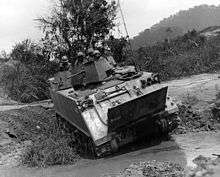
The "armored cavalry assault vehicle" or "ACAV", was a concept and field modification pioneered by the ARVN in 1963 during the Vietnam War.[60] The ARVN troops utilized the M113 armored personnel carrier as an infantry fighting vehicle, and more often than not, as a light tank[61] by fighting mounted rather than as a "battle taxi" as dictated by U.S. Army doctrine.
After it was found that the commander and cargo hatch positions were extremely exposed, and hence the commander and troops were vulnerable to enemy fire, South Vietnamese engineers thought out a simple and cheap remedy to this problem: Initially, field expedient shields and mounts were made from sunken ships,[62] but this was soft metal and could be penetrated by small arms fire. Then armor plate from scrapped armored vehicles was used; this worked well, and by the end of 1964 all ARVN ACAVs were equipped with gun shields.[63] For the U.S. Army, ACAV sets were produced industrially in Okinawa for the 12.7 millimetres (0.50 in) machine gun, and rear aft and starboard M60 machine gun positions. Finally, the ARVN's ACAV modifications were adopted by the U.S. Army in Vietnam,[64] and by 1965 the full ACAV set was mass-produced in the U.S. The kit included shields and circular turret armor for the commander's M2 12.7 mm machine gun, and two additional 7.62 mm M60 machine guns, again with shields, fitted on either side of the top cargo hatch. This kit could be retrofitted to any M113. ACAV sets were sometimes fitted to the M106 mortar carrier, but the different rear hatch found on this vehicle required the left M60 machine gun to be fitted to the extreme rear instead of the side. Many kits were added in the field, but at least in the case of the 11th Armored Cavalry Regiment, the vehicles had their ACAV sets installed in the U.S. prior to their deployment to Vietnam in 1966 from Fort Meade, Maryland.[64] Additional armor in the form of a mine protective kit under the hull was also frequently fitted.
Derivatives
A huge number of M113 variants have been created, ranging from infantry carriers to nuclear missile carriers. The M113 has become one of the most prolific armored vehicles of the second half of the 20th century, and continues to serve with armies around the world into the 21st century. Not without its faults, the otherwise versatile chassis of the M113 has been used to create almost every type of vehicle imaginable. Few vehicles ever created can claim the application to such a wide range of roles.
- M58 Wolf system
A smoke screen generator vehicle
A mortar carrier armed with an M30 mortar 106.7mm (4.2 inch, or "Four-deuce") mounted on a turntable in the rear troop compartment. On this variant, the single hatch over the rear troop compartment was exchanged for a three-part circular hatch. The mortar could be fired from the vehicle, but could also be fired dismounted. Currently, the U.S. Army mortar carrier is the M106 upgraded to A3 standard and armed with an M121 120mm mortar, a variant of the M120 mortar
Armed with an M121 120mm mortar, a variant of the M120 mortar.
- M125
Another mortar carrier, basically an M106 armed with an M29 81mm mortar
Variant equipped with a turret armed with a flamethrower and a .50 caliber machine gun. These vehicles are no longer used by the U.S. Army. Vehicles upgraded to A1 standard were known as "M132A1s".
- M150
Anti-tank variant equipped with a TOW ATGM launcher
Anti-aircraft variant equipped with a turret armed with a variant of the 20mm M61 Vulcan cannon
Anti-aircraft variant equipped with a launcher armed with four MIM-72A/M48 Chaparral missiles
Unarmored cargo carrier equipped with a rear cargo bed

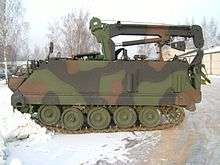
- M577
Command variant, the roof over the rear troop compartment is higher. The vehicle also carries additional radios and a generator. A variant of this is the M1068 standard integrated command post system carrier, equipped with the newest U.S. Army automated command and control system.
- M579
A fitter and repair vehicle equipped with a crane. This vehicle was not taken into U.S. Army service.
- M806
Repair and recovery vehicle equipped with an internal winch and two earth anchors mounted on the rear hull
- M901 ITV (improved TOW vehicle)
Equipped with a launcher armed with two TOW missiles.
- M113 "MBT" (NTC)
A variant of the M113 fitted with a modified Bradley turret as part of a vismod package specifically for training. This version also features MILES gear, a MGSS/TWGSS system, and fake ERA around the turret.
- M113 "C&R" (command and reconnaissance)
A lowered and shortened version of the M113 developed for the Netherlands. It was used for reconnaissance duties with cavalry battalions and armoured engineer companies. It had four road wheels on either side. The engine was moved to the rear of the vehicle although the drive sprockets were maintained at the front. Armament was a 25mm cannon in a remotely operated turret. Crew consisted of commander, driver and gunner. It has also been used by the Canadian Army as 'Lynx reconnaissance vehicle'.
A development of the M113A1 APC, upgraded with an enclosed turret and firing ports.
- Others
In 1994, a stretched version of the M113 was presented by its manufacturer, also known as "mobile tactical vehicle light" (MTVL). Its hull is lengthened by 34 inches and equipped with an additional road wheel (six on each side) to sustain the added dry weight and payload. The vehicle was developed as a "production-tooled demonstrator" with private-industry funding from United Defense. Although the U.S. Army did not buy it, it was acquired by other nations, and is copied today by Pakistan, Turkey and Egypt in their local M113-producing plants. Some nations, like Canada[65] and Australia, also stretched existing M113-hulls.[66]
- M113 copies
Several countries acquired M113s and later copied the design and proceeded to produce clones or evolved models (post-M113A3-standard) in their own indigenous factories. Pakistan produces an armored personnel carrier known as Talha which has a number of mechanical and automotive parts in common with the M113. Turkey produces the ACV-300 based on the AIFV. Egypt produces many variants of the M113A4 including the Egyptian infantry fighting vehicle (EIFV), which features a combination of an M113A3-base and the fully functional and stabilized two-man turret of the M2 Bradley. Iran is also producing its own M113s.
Operators
Current operators
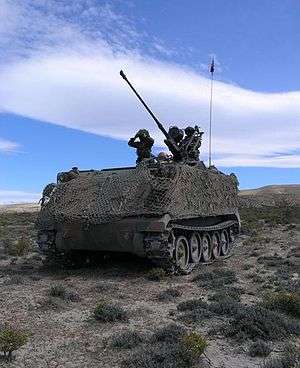
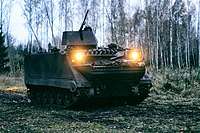


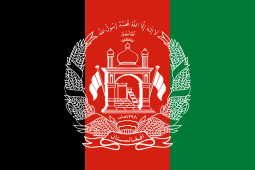


.svg.png)




.svg.png)





































Former operators
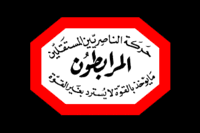


.svg.png)
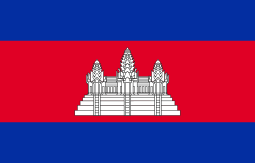
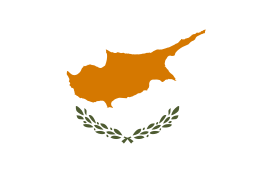
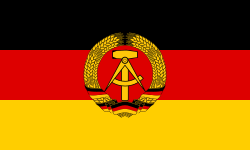

- Guardians of the Cedars: some captured from the Lebanese Army

.svg.png)
.svg.png)

.svg.png)


- Zgharta Liberation Army (a.k.a. Marada Brigade): some captured from the Lebanese Army[113]


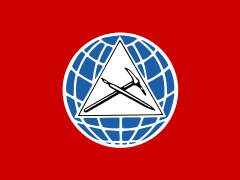
- South Lebanon Army: Captured from the Lebanese Army or supplied as aid by Israel[115]

- Tigers Militia: Some captured from the Lebanese Army


Civilian operators


Evaluation-only operators


See also
- MICV-65 – a failed project to introduce an improved APC
- Lynx reconnaissance vehicle - The same manufacturers, uses M113A1 components.
- AIFV – FMC's "Product Improved M113A1" from MICV-65, which saw sales to NATO countries and production under license by FNSS for the Turkish Army
- ACV-300 – Turkey's replacement for the M113
- FV432 – a contemporary British APC with similar appearance
- MT-LB – a contemporary Russian APC
- MLVM – a contemporary Romanian APC
- Pbv 302 – Swedish APC
- Boxer MRAV – Germany's replacement for the M113
- G-numbers (SNL G294)
- List of U.S. military vehicles by model number
- Type 63 – a Chinese APC
Footnotes
- Notes
- 2/2nd Mechanized Infantry, 1/5th Mechanized Infantry, 2/8th Mechanized Infantry, 1/16th Mechanized Infantry, 2/22nd Mechanized Infantry, 4/23rd Mechanized Infantry, 2/47th Mechanized Infantry, 1/50th Mechanized Infantry, 5/60th Mechanized Infantry, 1/61st Mechanized Infantry, and the 1st Brigade, 5th Infantry Division (Mechanized). The U.S. Army 1st Brigade, 5th (Mech) Infantry Division in Vietnam was not composed of strictly mechanized infantry battalions. The 5th (M) ID (1st Bde), consisted of: the 5/4th Field Artillery, 1/11th Light Infantry (straight leg-no armored vehicles), 1/77th Armor (M48 Patton tanks), 1/61st Mechanized Infantry, A Troop 4/12th Armored Cavalry (only one troop of cavalry), and the 3/5th Armored Cavalry OPCON (operationally controlled) /attached from the 9th Infantry Division. The one troop of the 12th Armored Cavalry and the full squadron of the 5th Armored Cavalry were M551 Sheridan and M113 ACAV equipped.
- Cites
- UN Mission in the Central African Republic MINUSCA (3 May 2012). "BF1V3726". flickr.com. Archived from the original on 10 October 2017. Retrieved 29 October 2017.
- "BAE Systems M113 Vehicles History". United Defense. Archived from the original on 7 January 2010. Retrieved 20 May 2010.
- "M113A3 Armored Personnel Carrier". Military Today. Archived from the original on 21 May 2019. Retrieved 15 March 2019.
- "M113 Armored Personnel Carrier". Inetres. Archived from the original on 2 December 2005. Retrieved 20 November 2005.
- "M113A2 APC". First Division Museum. Retrieved 4 August 2020.
- "M59 armored personnel carrier", Wikipedia, 20 March 2020, retrieved 2 April 2020
- Starry p. 73/Dunstan p. 107.
- "M113A3 FAMILY OF VEHICLES" Archived 8 August 2008 at the Wayback Machine, BAE Systems
- "The 10 Greatest Infantry Fighting Vehicles in Military History". The Military Channel. Missing or empty
|series=(help) Web page: Top Ten Infantry Fighting Vehicles Archived 17 December 2008 at the Wayback Machine. Retrieved 26 November 2008.. - "The ground combat vehicle strategy: Optimizing for the future" (PDF). U.S. Army. Archived from the original (PDF) on 30 April 2011. Retrieved 21 December 2016.
- Army Mulls $1.7 Billion Effort To Replace 3,000 M113s Archived 13 April 2013 at the Wayback Machine - Defense.AOL.com, 29 May 2012
- Ya'alon approves addition of 200 advanced APCs for the IDF Archived 3 March 2016 at the Wayback Machine Yossi Yehoshua Published: 09.22.14
- Simon Dunstan, The M113 Series, page 5, Osprey Publishing, London, 1983
- Tunbridge, 1978. p. 4.
- Dunstan p. 36.
- Dunstan p. 37.
- Dunstan p. 48.
- Dunstan p. 52.
- Zumbro, 1998. p. 470.
- "Band-Track website from the M113's manufacturer, BAE". Archived from the original on 3 July 2008. Retrieved 17 October 2009.
- John Pike (2 October 2012). "M113 Armored Personnel Carrier". GlobalSecurity.org. Archived from the original on 28 February 2007. Retrieved 26 February 2007.
- Dunstan/Vietnam Tracks/p. 92 footnote
- Foss 1987, pp. 442–443.
- Davidson, Graeme (2005), Modelling the M113 Series, Osprey, ISBN 978-1-84176-822-9 p. 4 Archived 28 June 2014 at the Wayback Machine
- Gansel, Markus, "Elefantenschuh", Das Bundeswehrlexikon (in German), archived from the original on 1 August 2011, retrieved 1 May 2011
- Gansel, Markus, "Panzerunterlegekeil", Das Bundeswehrlexikon (in German), archived from the original on 1 August 2011, retrieved 1 May 2011
- Shin, Yun-ho; Chung, Jung-hoon; Kim, Jong-hwan (2018). "Test and estimation of ballistic armor performance for recent naval ship structural materials". International Journal of Naval Architecture and Ocean Engineering. 10 (6): 762–781. doi:10.1016/j.ijnaoe.2017.10.007.
- Nuckols, William T.; Cameron, Robert S. "Don't Harness an Ox to a Racehorse: Get the M113 Out of the Armored Brigade Combat Team … Now, Please!" (PDF). www.benning.army.mil. FORT BENNING U.S. Army Fort Benning and The Maneuver Center of Excellence.
- Hazell, Paul J. (29 July 2015). Armour: Materials, Theory, and Design. CRC Press. ISBN 9781482238303.
- Army's Evaluation of Stryker and M-113A3 Infantry Carrier Vehicles Provided Sufficient Data for Statutorily Mandated Comparison (PDF) (Report). May 2003. p. 19. Archived (PDF) from the original on 24 September 2015. Retrieved 22 October 2015.
- Each cylinder in a Detroit 53 series engine has a capacity of 53 cu. in., x 6 = 318 cu. in.
- Starry pp. 227–237.
- "D/16 Official Army History January - March 1968" (PDF). Archived (PDF) from the original on 19 March 2014. Retrieved 18 March 2014.
- D/16 Armor Website, Army original source documents, http://www.d16armor173rd.org/documents--publications.html Archived 18 March 2014 at the Wayback Machine
- "Photo: U.S. advisor confers with ARVN 3rd Cav commander in front of a South Vietnamese M113". Archived from the original on 14 June 2010. Retrieved 11 June 2010.
- "3d Armored Cavalry Squadron (ARVN) earned Presidential Unit Citation (United States) for extraordinary heroism" (PDF). Archived from the original (PDF) on 16 July 2011. Retrieved 11 June 2010.
- "Estimated Number Of Personal Arms Left Behind, 1975". Archived from the original on 24 August 2016. Retrieved 26 January 2019.
- "Nagmash / Zelda (M113)". Archived from the original on 1 September 2018. Retrieved 1 September 2018.
- Gott, Kendall D.: Breaking The Mold: Tanks In The Cities [Illustrated Edition]
- Amnon Barzilai (10 June 2004). תוכנית "נמרה": טנק המרכבה 1 יוסב לנגמ"ש [Program "Nemmera": Tank will be altered APC]. Haaretz (in Hebrew). Archived from the original on 6 September 2014. Retrieved 18 August 2014.
- "Defense Ministry doubles orders for tank, Namer APC parts". JPost. 3 March 2015. Archived from the original on 12 May 2015. Retrieved 5 May 2015.
- "Soldiers refuse to board obsolete, unprotected APC". Archived from the original on 1 September 2018. Retrieved 1 September 2018.
- Israel Builds First Prototype of Future Fighting Vehicle - Defensenews.com, 25 October 2015
- "Defense Ministry approves new armored vehicles for IDF". Archived from the original on 1 September 2018. Retrieved 1 September 2018.
- Perkins, Nancy; J. O'Donoghue, Amy (15 April 2008). "FLDS at ranch detail raid by Texas officials". Archived from the original on 8 October 2017. Retrieved 16 January 2017 – via Deseret News.
- Vendors Pour Funding Into Armored Vehicle Development Archived 4 September 2015 at the Wayback Machine - Nationaldefensemagazine.com, 17 December 2012
- "11 by 17.fm" (PDF). Archived from the original (PDF) on 30 April 2011. Retrieved 3 July 2010.
- "U.S. Army Details Ground Combat Vehicle Plans". Defense News. 10 September 2009. Retrieved 3 July 2010.
- "Rapid Fire March 30, 2012: Armored Multi-Purpose Vehicle". defenseindustrydaily.com. Archived from the original on 27 June 2017. Retrieved 8 February 2017.
- Army Develops New Concepts, Keeps Existing Fleets Rolling - Defensenews.com, 12 October 2014
- HASC Throws General Dynamics Little Bone On AMPV Archived 6 May 2014 at the Wayback Machine - Breakingdefense.com, 1 May 2014
- MRAPs Join Competition to Replace Troop Carriers Archived 19 October 2014 at the Wayback Machine - Military.com, 20 May 2014
- 70-Year-Old M113s: The Army’s Long March To AMPV Archived 5 April 2015 at the Wayback Machine - Breakingdefense.com, 31 March 2015
- "Soldiers to operate armed robotic vehicles from upgraded Bradleys | Article | The United States Army".
- Vietnam-Vintage Vehicles Blaze Trail For Robot Tanks: Army RCV Archived 3 September 2018 at the Wayback Machine. Breaking Defense. 30 August 2018.
- Foss 1987, p. 444.
- Foss 1987, p. 436.
- M113 Archived 21 August 2008 at the Wayback Machine - AFVDB.com
- "Introduction to the M113A3 Armored Personnel Carrier". Technical Publishing. Archived from the original on 7 October 2017. Retrieved 16 July 2018.
- Starry pp. 38, 40, 73.
- Starry p. 42.
- Starry p. 38.
- Starry p. 40.
- Starry p. 73.
- John Pike. "M113A3+/M113A4 Mobile Tactical Vehicle Light (MTVL)". Globalsecurity.org. Archived from the original on 22 May 2010. Retrieved 3 July 2010.
- M113AS Upgrade (PDF), BAE Systems Australia, archived from the original (PDF) on 28 August 2010, retrieved 20 May 2010
- "Trade Registers". armstrade.sipri.org. Archived from the original on 14 April 2010. Retrieved 8 January 2018.
- Armoured Vehicles Global Inventories 2016-17 (PDF). Defence iQ. 2016.
- Higuera, Jose (13 June 2017). "Argentine Army announces armor upgrade programmes". IHS Jane's 360. Archived from the original on 13 June 2017. Retrieved 13 June 2017.
- Houston and Handel, Bill and Paul (9 April 2015). "Half a century's service" (PDF). Army: The Soldiers' Newspaper (1348 ed.). Canberra, Australia: Department of Defence. ISSN 0729-5685. Archived (PDF) from the original on 27 August 2016. Retrieved 8 August 2016.
- Stockholm International Peace Research Institute. "Transfers and licensed production of major conventional weapons". Archived from the original on 14 April 2010. Retrieved 10 December 2011.
- Defense Security Cooperation Agency. "Excess Defense Articles". Archived from the original on 14 January 2012. Retrieved 10 December 2011.
- DEFENCE BALANCE IN WESTERN BALKANS Archived 28 September 2007 at the Wayback Machine Research Institute for European and American Studies
- "Equipment - Canadian Army - M113A3". Department of National Defence. Archived from the original on 10 June 2011. Retrieved 18 December 2009.
- "Denmark Seeks Bids for Armored Personnel Carriers". defensenews.com. Retrieved 8 February 2017.
- "M113". www.deutschesheer.de. Archived from the original on 13 November 2016. Retrieved 29 October 2017.
- "Iraq -Refurbishment of M113A2 Armored Personnel Carriers" (PDF). 22 September 2010. Archived from the original (PDF) on 21 July 2011. Retrieved 26 September 2010.
- Excess armored personnel carriers benefit U.S., foreign partners Archived 18 July 2013 at the Wayback Machine - Army.mil, 28 June 2013
- "TNI Menunggu 100 unit M 113 dari Belgia" (in Indonesian). Lancer Cell Indonesia. 28 May 2016. Archived from the original on 31 March 2017. Retrieved 8 February 2017.
- Bill Roggio & Kaled Weiss (25 June 2015). "Hezbollah Brigades flaunts US equipment in Anbar operation". Long War Journal. Archived from the original on 13 July 2015. Retrieved 14 July 2015.
- "US gives Jordan 150 M577 Command Post Vehicles". Army Recognition. 20 February 2018. Archived from the original on 20 February 2018. Retrieved 24 February 2018.
- United States gives 200 M113s to Lebanon Archived 12 January 2013 at the Wayback Machine - Armyrecognition.com, 8 January 2013
- "M113 / M113A1, M113A2, M113A3". Deagel.com. 12 April 2011. Archived from the original on 4 January 2011. Retrieved 1 May 2011.
- "Lithuania buys M577 armoured personnel carriers to complement units of the Lithuanian Armed Forces". kam.lt. Archived from the original on 5 February 2017. Retrieved 8 February 2017.
- 330 M113A2, 420 M113A1, 13 M113A1-B, 23 M901A1, 115 M163 VADS, 38 M548A1, 163 M577A2, 14 M981 FISTV, 20 M125A1, 113 M106A1 and 32 M106A2, 73 M730 "Archived copy". Archived from the original on 14 January 2012. Retrieved 10 December 2011.CS1 maint: archived copy as title (link)
- Forsvarsdepartementet (13 October 2014). "Prop. 1 S (2014–2015)". regjeringen.no. Archived from the original on 12 September 2017. Retrieved 8 February 2017.
- "BAE Systems Wins New Land Contracts in Nordic Markets". www.defense-aerospace.com. Archived from the original on 6 February 2017. Retrieved 6 February 2017.
- Forsvarsdepartementet (9 February 2017). "Hæren får nye pansrede transportpanservogner". Regjeringen.no (in Norwegian). Archived from the original on 11 February 2017. Retrieved 9 February 2017.
- Mönch Publishing Group (30 May 2018). "FFG Support Vehicles for Norway". Monch.com. Archived from the original on 1 July 2018. Retrieved 1 July 2018.
- "Pakistan Army". Archived from the original on 13 May 2013.
- https://web.archive.org/web/20180729223030/http://www.discasanave.com/productos-militares/modernizacion-de-carros-de-combate/obus-autopropulsado
- David Saw. "The Philippine Army – Developing a Modernisation Strategy". SP's Land Forces. Archived from the original on 4 December 2014. Retrieved 27 June 2014.
- Parameswaran, Prashanth. "US Gives Philippines 114 Military Vehicles". The Diplomat. Archived from the original on 16 December 2015. Retrieved 8 February 2017.
- "List of armaments of the Polish Army as of June 2005". Militarium.net. Archived from the original on 26 August 2013. Retrieved 1 May 2011.
- "M-113 A1/A2 - FMC-United Defense / BAE Systems / Portugal". Área militar. Archived from the original on 30 September 2009. Retrieved 7 May 2011.
- "M901 ITV - FMC-United Defense / BAE Systems / Portugal". Área militar. Archived from the original on 30 September 2009. Retrieved 7 May 2011.
- "M-730 / M48A3 "Chaparral" - Lockeed Martin / Portugal". Área militar. Archived from the original on 30 September 2009. Retrieved 7 May 2011.
- "M577 A2 - FMC-United Defense / BAE Systems / Portugal". Área militar. Archived from the original on 30 September 2009. Retrieved 7 May 2011.
- John Pike (20 April 2009). "ROC Army Equipment". Globalsecurity.org. Archived from the original on 29 April 2011. Retrieved 1 May 2011.
- ARG. "M113 Armored Personnel Carrier | Military-Today.com". www.military-today.com. Archived from the original on 23 January 2018. Retrieved 16 January 2018.
- Kassis, Véhicules Militaires au Liban/Military Vehicles in Lebanon (2012), pp. 46-47.
- El-Assad, Blue Steel III: M-113 Carriers in South Lebanon (2007), p. 8.
- Kassis, 30 Years of Military Vehicles in Lebanon (2003), pp. 64-65.
- Jureidini, McLaurin, and Price, Military operations in selected Lebanese built-up areas (1979), appendix A, table A-6.
- Hokayem, L'armée libanaise pendant la guerre: un instrument du pouvoir du président de la République (1975-1985) (2012), pp. 29-30.
- The Action of the Captured M47 in Attila II in The Unknown Soldier of Cyprus (Savvas Vlassis)
- Debay, Yves (2003). Operation Iraqi Freedom: Road to Baghdad. Special Obs 26. Concord Publication. p. 64. ISBN 962-361-066-1.
- Meek, James (23 March 2003). "Nightmare in a minefield". The Guardian. Archived from the original on 5 September 2018. Retrieved 4 September 2018.
- Kassis, Véhicules Militaires au Liban/Military Vehicles in Lebanon (2012), pp. 40; 59.
- Kassis, 30 Years of Military Vehicles in Lebanon (2003), p. 23.
- Kassis, Véhicules Militaires au Liban/Military Vehicles in Lebanon (2012), pp. 49-50.
- Kassis, Véhicules Militaires au Liban/Military Vehicles in Lebanon (2012), pp. 62-63.
- Kassis, 30 Years of Military Vehicles in Lebanon (2003), p. 25.
- Kassis, 30 Years of Military Vehicles in Lebanon (2003), p. 57.
- Kassis, Véhicules Militaires au Liban/Military Vehicles in Lebanon (2012), p. 82.
- Abbott, Peter (20 February 2014). Modern African Wars (4): The Congo 1960–2002. Men-at-Arms 492. Osprey Publishing. p. 33. ISBN 9781782000761.
- "M113 Armored Personnel Carrier: The Perfect Astronaut Rescue Vehicle". Space Safety Magazine. 2 February 2012. Archived from the original on 15 January 2018. Retrieved 15 January 2018.
- "STS-106 KSC-00PP-1135 - STS-106 Commander Wilcutt drives the M113". 23 July 2004. Archived from the original on 23 July 2004. Retrieved 15 January 2018.
References
- El-Assad, Moustafa. Blue Steel III: M-113 Carriers in South Lebanon. Sidon, Lebanon: Blue Steel Books, 2007.
- Dunstan, Simon. The M113 Series London, UK: Osprey Publishing, 1983. ISBN 0-85045-495-6.
- Dunstan, Simon. Vietnam Tracks-Armor In Battle 1945–1975. (1982 edition Osprey Books); ISBN 0-89141-171-2.
- Foss, Christopher F. Jane's Armour and Artillery 1987–88. London: Jane's Yearbooks, 1987. ISBN 0-7106-0849-7.
- Nolan, Keith W. Into Laos: Dewey Canyon II/Lam Son 719. Novato, CA: Presidio Press, 1986. ISBN 0-89141-247-6.
- Starry, Donn A., General. "Mounted Combat In Vietnam" (Archived) Vietnam Studies; Department of the Army. First printed 1978-CMH Pub 90-17.
- Tunbridge, Stephen. M113 in Action. Carrollton, TX: Squadron/Signal Publications, Inc, 1978. ISBN 0-89747-050-8.
- Zaloga, Steven. Armored Thunderbolt, The US Army Sherman in World War II. 2008, Stackpole Books. ISBN 978-0-8117-0424-3.
- Zumbro, Ralph. The Iron Cavalry. 1998, New York, New York, Pocket Books. ISBN 0-671-01390-4
Secondary sources
- Joseph Hokayem, L'armée libanaise pendant la guerre: un instrument du pouvoir du président de la République (1975-1985), Lulu.com, Beyrouth 2012. ISBN 9781291036602, 1291036601 (in French) –
- Samer Kassis, 30 Years of Military Vehicles in Lebanon, Beirut: Elite Group, 2003. ISBN 9953-0-0705-5
- Samer Kassis, Véhicules Militaires au Liban/Military Vehicles in Lebanon 1975-1981, Trebia Publishing, Chyah 2012. ISBN 978-9953-0-2372-4
- Paul Jureidini, R. D. McLaurin, and James Price, Military operations in selected Lebanese built-up areas, 1975-1978, Aberdeen, MD: U.S. Army Human Engineering Laboratory, Aberdeen Proving Ground, Technical Memorandum 11-79, June 1979.
External links
| Wikimedia Commons has media related to M113. |
- BAE Systems
- FAS.org
- Gary's Combat Vehicle Reference Guide
- M113 at Israeli Weapons
- Dutch Cavalry Museum has an M113 C&V (M113 ACAV) in its collection.
- "M113 APC: four decades of service and still showing potential", Infantry Magazine, July–August 2004, by Stanley C. Crist.
- M113 Technical Manuals Technical Library for M113 APC